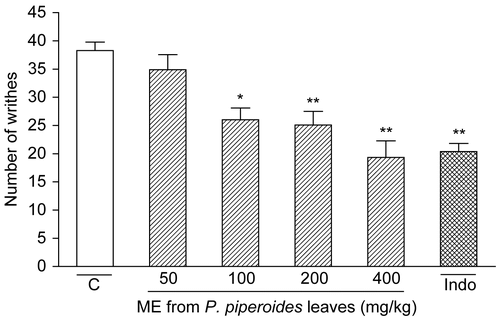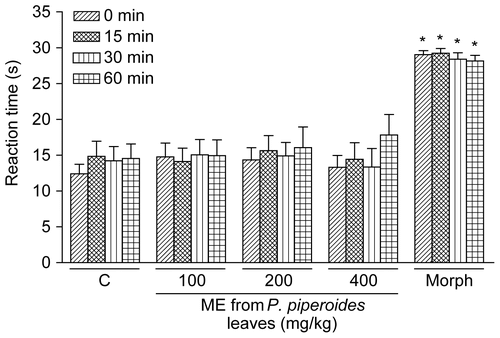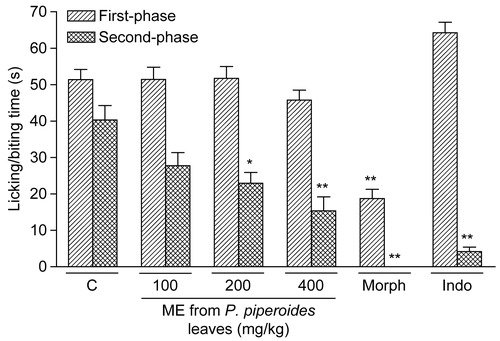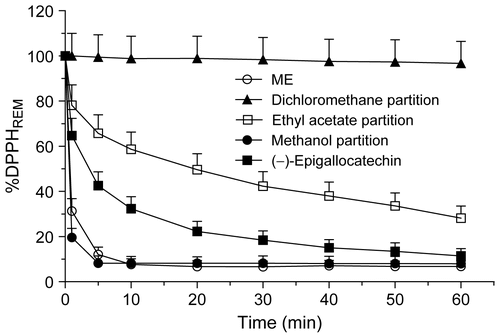Figures & data
Table 1. Phytochemical screening of P. piperoides ME.
Figure 1. Influence of P. piperoides methanol extract (ME) in nociceptive behavior of mice evaluated in acetic acid-induced abdominal writhing model. Nociception was registered by the number of writhes that the animal presented 20 min following i.p. acetic acid injection. Groups of animals were pre-treated with vehicle (C, control group, open column, n = 9), indomethacin (Indo, 10 mg/kg, cross-hatched column, n = 9), or ME (50– 400 mg/kg, right-hatched columns, n = 9/dose), p.o., 60 min before irritant agent. Each column represents the mean ± SEM. Asterisks denote statistical significance, *p < 0.01 and **p < 0.001, in relation to control group. ANOVA followed by Tukey’s test.

Figure 2. Influence of P. piperoides ME on nociceptive behavior of mice in the hot-plate test. Nociception was evaluated as the latency (reaction time, in s) for animals to elevate paws from the plate warmed to 55 ± 0.5°C. Groups of mice were pre-treated with vehicle (C, control group, 10 mL/kg, p.o., 60 min beforehand, n = 9), morphine (Morph, 10 mg/kg, i.p., 30 min beforehand, n = 9), or P. piperoides ME (100– 400 mg/kg, p.o., 60 min beforehand, n = 9/dose) and measurements were performed at times 0 (right-hatched columns), 15 (cross-hatched columns), 30 (striped columns), and 60 min (squared columns) after the first thermal stimulus. Each column represents the mean ± SEM. Asterisks denote statistical significance, *p < 0.001 in relation to control group. ANOVA followed by Tukey’s test.

Figure 3. Effect of P. piperoides ME in nociceptive behavior of mice evaluated in formalin-induced nociception model. Groups of mice were pre-treated with vehicle (columns C, control groups, 10 mL/kg, p.o., 60 min beforehand, n = 9), indomethacin (Indo, 10 mg/kg, p.o., 60 min beforehand, n = 9), morphine (Morph, 10 mg/kg, i.p., 30 min beforehand, n = 9), or P. piperoides ME (100– 400 mg/kg, p.o., 60 min beforehand, n = 9/dose) against the early phase (0–5 min, right-hatched columns) or late phase (20–25 min, cross-hatched columns) of formalin-induced nociception in mice. Each column represents the mean ± SEM. Asterisks denote statistical significance, *p < 0.05 and **p < 0.001 in relation to control group. ANOVA followed by Tukey’s test.

Figure 4. Effect of P. piperoides ME on rat paw edema induced by carrageenan. Groups of rats were pre-treated with vehicle (control group, 10 mL/kg, p.o., n = 6), aspirin (AAS, 300 mg/kg, p.o., n = 6), or P. piperoides ME in concentrations of 100, 200, and 400 mg/kg (p.o., n = 6/dose) 60 min before carrageenan-induced paw edema. Measurements were performed at times 0, 1, 2, 3, and 4 h after the subplantar injection of carrageenan (1%, 100 μL). Each value represents the mean ± SEM. Asterisks denote statistical significance, *p < 0.05 and **p < 0.001 in relation to control group. ANOVA followed by Tukey’s test.

Table 2. Radical scavenging activities of P. piperoides extract and partitions determined by the reduction of DPPH free radical.
